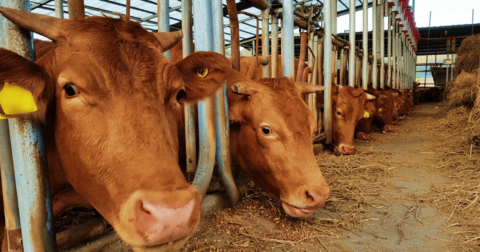Explainer
How Overconsumption Affects the Environment and Health, Explained
Climate•12 min read
Reported
The investigation reveals evidence of government willingness to accept an alternative accounting method that is the darling of the meat and dairy industry.


Words by Sophie Kevany
An alternative methane emissions measurement known as GWP* (pronounced GWP Star) would allow meat and dairy companies to report significantly lower and even negative greenhouse gas emissions, without reducing the number of animals used in factory farm operations, a new report finds. Methane is a significant contributor to global warming, and 32 percent comes from livestock, primarily cattle burps and manure management.
The report, released Friday, lays out the extent to which some meat and dairy companies might use GWP* to mask the impact of their emissions, turning them from positive to negative to appear “climate neutral.” Embraced by the meat and dairy industries since its creation, GWP* accounting allows companies reliant on large-scale, factory farming to present even small methane reductions as “pulling carbon out of the atmosphere,” says Nusa Urbancic, the report’s co-author and CEO of Changing Markets Foundation, an non-profit that investigates corporate practices.
GWP, or Global Warming Potential, is one of the most common climate metrics and is used for converting the warming effects of different gasses to a standard measurement known as carbon dioxide equivalent. There are different GWP measurements but under the international, legally binding Paris Agreement to limit global warming to a 1.5 percent increase, countries are obliged to use the 100 year, or GWP100, metric.
The GWP* metric was originally developed in 2018, by a group of researchers from the Oxford Martin School who argued that more commonly used GWPs, like GWP100, do not account for the way different greenhouse gasses have different atmospheric lifetimes and radiative impacts. Since methane has a shorter lifespan than CO2, they argue, GWP100 “falls short in many scenarios.”
In practice, however, says Urbancic, the GWP* metric essentially allows “the biggest producer countries and companies to avoid reducing the number of livestock and transforming food production systems.”
The key difference between GWP* and GWP100, Urbancic says, is that instead of measuring a conversion of methane into CO2 over a 100 year-period, GWP* allows “the scientists and industry groups promoting GWP* [to] assume that the baseline emissions would be set in the recent past, so the change in methane emissions would be compared to a much higher baseline.” Critically, this “kind of hides existing emissions,” says Urbancic. In essence, GWP* “normalizes existing emissions and disproportionately rewards even small methane reductions.”
The report also revealed evidence that Ireland’s agriculture ministry is on board with this strategy and “keen to adopt” GWP*. As one internal government document shows, the adoption of GWP* is linked to fears the country may, “[fail] to achieve an ambitious 51% reduction target” by 2030 as a result of methane emissions from the agriculture sector.
Another concern cited in the internal document is that “mitigation options for methane are limited with the primary technological advancement (feed additives) some years off widespread adoption (likely to be late in decade or post 2030).” This document and others were obtained by Changing Markets under freedom of information rules and seen by Sentient Media.
The topic of methane and emission reduction is a sensitive one given that Ireland is proud of its dairy exports, which hit a record value of €6.8 billion in 2022. Yet the same internal document goes on to say that some Irish modeling scenarios suggest cattle numbers would have to fall “from 7.2m [million beef and dairy] animals to approximately 4m to get close to this [51 percent] level of reduction.”
These numbers are a far cry from current discussions which are focused on reducing Ireland’s 1.6 million dairy herd by about 200,000 over the next three years. The document called out GWP* as important for “countries with significant livestock based agricultural production systems … [because] GWP100 likely overstates the warming potential of methane from livestock.”
The freedom of information request also revealed internal briefing documents for Ireland’s international trade representatives, which stated that the agriculture ministry “would like to see progress in the area of metrics (GWP* v GWP100) which would better reflect the global warming impact of methane from livestock production systems.” To show the effects of using GWP* instead of GWP100, the Changing Markets report uses both metrics to calculate emission reduction targets for Tyson, one of the world’s largest meat companies, Fonterra, the world’s largest dairy exporter, and New Zealand.
For Tyson, an emissions reduction plan of 30 percent by 2030 using GWP* accounting means that, come 2030, the company would be removing almost 83 million metric tons from the atmosphere, according to Urbancic. Yet the same calculation using GWP100 for that time period, suggests the company would actually be releasing — putting almost 60 million metric tons of pollution out into the atmosphere. Tyson has told Sentient Media that it uses GWP100 and “does not consider GWP* as an option.”
In another of the report’s examples, if Fonterra used GWP* to calculate a 30 percent emission cut by 2030, the company could, come 2030, claim to be removing 19 million metric tons of carbon dioxide equivalent per year. But, again, by calculating emissions using the standard GWP100, the dairy giant would actually be emitting almost 22 million metric tons.
In the U.S., says Urbancic, the National Cattlemen’s Beef Association, a trade group representing cattle producers and meat companies such as Tyson and McDonalds, has used GWP* “to argue that American cattle ‘may not be contributing much at all to global warming’ and says it is working internationally via the International Beef Alliance ‘to ensure that everybody is working towards adoption of GWP*.’”
For New Zealand, where half of the country’s emissions come from agriculture, a 10 percent emissions reduction target using GWP* could render the entire country methane negative by 2038, the report finds. Yet using GWP100, the report says the same scenario would put emissions at 30 million metric tons of methane released into the atmosphere each year up to 2050.
Asked for comment a New Zealand ministry spokesperson said in an email: “GWP* is a relatively new metric. Under the Paris Agreement, Aotearoa New Zealand must report its progress against its international targets using GWP100. New Zealand currently reports on all its greenhouse gas emissions, including biogenic methane, using the GWP100 metric.”
In an email Tyson Foods said it uses “Intergovernmental Panel on Climate Change Global Warming Potentials (GWPs) and does not consider GWP* as an option to calculate emissions.” The company reiterated its 2030 reduction commitment outlined at its sustainability resource hub.
There was no response to requests for comment from the Irish agriculture ministry, Fonterra or the National Cattlemen’s Beef Association.
This piece has been updated to correct the projected emissions for Fonterra, and to correct a use of GWP100 in place of GWP*.